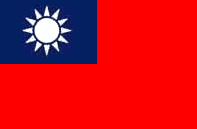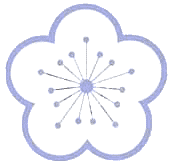(This info comes from the GIO site and other Taiwan info
sites: please forgive any copyright breaches.. please feel free to plagiarize
this site)
TAIWAN
Official Name
The nation's official name - the Republic
of China (Chung-hua Min-kuo) - was first proposed as the name of post-imperial
China by Sun Yat-sen at a meeting of the Tungmenhui (Revolutionary Alliance) in
Tokyo in 1905. When the last emperor was later dethroned, the Provisional
Assembly established in 1912 adopted the name, which has remained unchanged ever
since. Years in the ROC are calculated from the year of the Republic's founding
in 1912. Thus on many official documents, 1999 is "the 88th year of the
ROC."
National Anthem
The words of the ROC national anthem are drawn
from a speech made by Sun Yat-sen at the opening ceremony of the Whampoa
Military Academy on June 16, 1924. The exhortation served as a Kuomintang (KMT)
party song before it was combined with music written by Cheng Mao-yun to become
the national anthem.
The anthem expounds the "Three Principles of
The People" - nationalism, democracy and people's welfare, meaning in
essence "of the people, by the people, for the people." This
philosophy was devised by Sun Yat-sen and has been studied by generations of ROC
students. The anthem also calls upon the Chinese people to bravely and
ceaselessly strive for the betterment of the nation.
National Flag

The core of the ROC flag - the white sun in a
blue sky - was designed by the revolutionary Lu Hao-tun and publicly displayed
for the first time at the founding of the Society for Regenerating China (Hsing-chung
hui) in Hong Kong on February 21, 1895. A crimson background was added some
years later. After the Northern Expedition established Republican rule
throughout China in 1928, the flag was formally adopted by the ROC government.
The 12 points of the white sun represent the 12
two-hour periods into which Chinese people divide each day. This symbolizes
unceasing progress. Blue connotes brightness, purity and freedom, red indicates
fraternity, while white signifies honesty and equality.
National Flower

The plum blossom (prunus mei) was declared the
ROC's national flower on July 21, 1964. The blossom is a symbol of resilience in
the face of adversity, has three stamens symbolizing Sun Yat-sen's Three
Principles, and five petals, which represent the five branches of the ROC
government.


For
info about Taichung, this can't be beat!

Taiwan
Taiwan is located in the Pacific Ocean only 160 kilometers (120
miles) from Mainland China. The island straddles the Tropic of Cancer. Taiwan is
394 kilometers (236 miles) long and 144 kilometers (86 miles) at its greatest
width. The total area is about 36,000 square kilometers (13,808 square miles).
The area is a little larger than the combined states of Massachusetts and
Connecticut, or about the size of Holland or Vancouver Island.
A central mountain range runs the length of the main island of Taiwan, dividing
it east and west and dominating two-thirds of the land surface. While the
mountains descend steeply into the Pacific Ocean on the east coast, the highland
levels off gradually on the western side. The terraced tablelands and alluvial
coastal plains, formed on the west coast, are home to about 80 percent of
Taiwan's nearly 21 million people.
Overlying the tropical and subtropical zones, Taiwan sports a tropical climate
in the southern and western flatland and a temperate climate in the northland
and the mountainous regions. Taiwan's location is also subject to annual
typhoons, which pass through between the months of July and October. These
typhoons consist of strong winds and heavy rain.
The hottest temperatures are in July and August averaging 92 degrees Fahrenheit
(36 degrees Celsius). January is the coolest month with temperatures averaging
around 55 degrees Fahrenheit (10 degrees Celsius). The island remains
excessively humid throughout the year and receives abundant rainfall, with the
east (upland) receiving more than the west (lowlands). Except in the northern
region where rainfall is more even, the mean annual rainfall in other parts of
the island ranges from 102 to 200 inches. Some snow does fall on the summits of
the central range, but lowland Taiwan remains frost-free.
For more useful information about Taiwan, please visit the following:
Travel in Taiwan
http://www.sinica.edu.tw/tit/index.html
From the folks at Travel in Taiwan monthly magazine, this site has a really good
description on Chinese arts, culture, dining, business, museums, shopping and
more.
Hotel Guide Taiwan
http://hotel.cybertaiwan.com
http://www.hotelstravel.com/taiwan.html
Both sites offer a list of hotels with on-line reservations. The second site
also provides tourist information to other links including weather, health and
transportation.
Visitor’s Guide to Taiwan
http://peacock.tnjc.edu.tw/ADD/TOUR/main.html
This is the jump-off site for links describing the different regions of Taiwan
and other interesting information like outdoor activities, festivals, Taiwan
birds and Kinmen, the world’s most heavily fortified islands.
Taipei Municipal First Girl’s Senior High School
http://www.fg.tp.edu.tw
Taiwanese students have to pass demanding exams to get into high school. Only
the top students can get into this prestigious school right near the
Presidential Palace.
The Republic of China
http://peacock.tjnc.edu.tw/ROC.HTML
The mother of all Taiwan pages. This site is dedicated to all government issues.
There is also a link to the Factbook Home Page, which offers a lot of basic
facts and figures on Taiwan.
General Information
http://peacock.tjnc.edu.tw/ROC_info.html
This information is full of facts about the history, people and culture of
Taiwan.
ROC Environmental Protection Agency
http://www.epa.gov.tw/index.html
This site talks about Taiwan’s environmental laws and regulations.
World United Formosans for Independence
http://www.homer.cc.utexas.edu/students/tsa/org_wufi.html
We at Hess take no stands politically, but this page will give you an idea of
what to expect from the extreme independence end of the local political
spectrum.
Taiwan Research Institute http://www.taiwaninformation.org
This site provides studies on international and domestic economic and political
issues.
History of Taiwan
http://www.leksu.com/leksu-e.htm
This site provides extensive research on the past and future outlooks.
Asiaco
http://search.asiaco.com/Taiwan
The Asia Search Engine
Asian Studies Network Information Center
http://asnic.utexas.edu/asnic/countries/taiwan
This site has access to academic databases and information services worldwide.
There is even a site dedicated to the Chinese language and character analysis.
US Geological Survey
http://www.usgs.gov/taiwan.html
This site provides reliable scientific information about the earth. There is an
article that talks about the major earthquake that hit Central Taiwan in
September 21, 1999.
Community Services Center
http://www.community.com.tw
The center is based in Northern Taipei providing a number of services and
courses for the foreign community.
